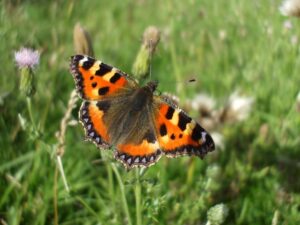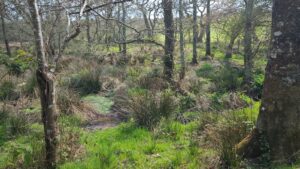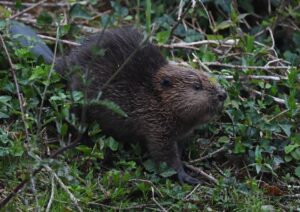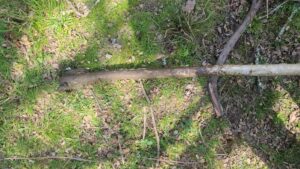Pasture Champions: Woodland Valley Farm, Cornwall 2/3
What do you do to encourage this biodiversity?
 Butterfly
Butterfly
The farm has always been reasonably rich in habitat, with minimal trimming of hedges for many years and some have not been touched for 30 years, with a relatively high proportion of woodland at 15% of total land cover.
 Heterogenous habitat
Heterogenous habitat
The vast majority of the woodland is native hardwood, but with a few scattered groups of evergreens among them. 40% of the woodland is around 180 years old, with many veteran trees and lots of deadwood.
This is situated all around the farmstead giving excellent shelter from winter storms and was planted about the same time as the farm was established. The remainder has been planted in the last 35 years or so, on those least productive steep or wet areas of farmland.
Our pastures are broadly herb and legume rich, with the intention of no longer using any temporary leys or restocking of grassland. The lower fields are currently being converted into wood pasture under Higher Tier Stewardship, with the planting being arranged in rows following contours.
This was not easy to achieve as Natural England were more interested in the aesthetic of a Capability Brown parkland rather than being able to farm effectively, or indeed actual biodiversity outcomes.
There was also the potential Environmental Impact Assessment if we exceeded planting 90 stems per hectare - another good example of the country achieving mediocrity through the application of excellent bureaucracy. Of course, no EIA required if one gives up farming and natural regeneration of woodland and scrub occurs.
How is it connected across the farm and beyond?
A particular highlight has been to introduce a pair of Eurasian beavers into an enclosure on the Nankilly Water. This has brought a whole range of issues to the fore and taught us a great deal about the importance of this keystone species. Initially we had hoped to just release several pairs into the valley to help slow the flow of water down into the village of Ladock, but at that time it would have been virtually impossible to get a license for that.
 Beaver
Beaver
Being in an enclosure meant that we could have tightly focussed hydrological monitoring AND learn more about the biodiversity that would come with the animals.
In brief, the beavers have resulted in peak flows being reduced by half on average, braiding of the stream such that there are four channels instead of one, 8 dams constructed, a mass of silt accumulated, rich in nitrate, phosphate and organic matter, a highly heterogeneous habitat, a lot of dead wood (over a hundred trees have been felled), habitat created, larger trout supported by the deeper water created, 17 species of dragonflies recorded and 11 of bats, 3 new mammal records (polecat, water shrew and harvest mouse) and 9 new bird records (including willow tit).
It is high time that our rivers were protected by compulsory buffers, to deliver WFD, and these would then provide the basis of the Nature Recovery Networks plank of the 25 Year Environment Plan - buffers would be a systemic solution to a systemic problem and would allow colonisation of beavers to be de-conflicted from farming operations from many landscape types across Britain.
 Silt on stick 15% organic matter
Silt on stick 15% organic matter
Analysis of the silt in the beaver ponds indicates 15% organic matter, so c 9% carbon. This is just the first step, but I know of no other data like this in England yet. In future years we will be assessing rate of accumulation of silt, and organic matter changes as well as other silt constituents.
Biodiversity is encouraged through philosophy. The food we grow has to come from an excellent ecosystem. If it does not we will not be able to keep producing food ad infintum.
The farm is physically connected to two other holdings which are extensively managed grass land, and 2,000 plus acres of intensive but organic dairy farm. It is conceptually connected more widely by membership of and networking through Cornwall Wildlife Trust, and of course the PFLA.
CONTINUE...



